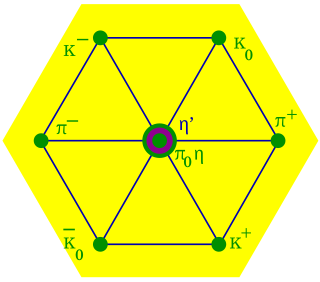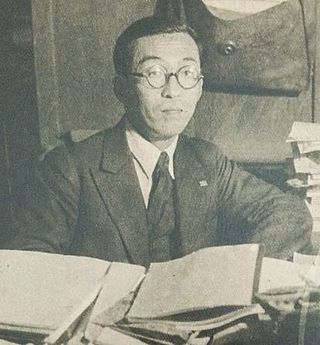Related Research Articles

In particle physics, a baryon is a type of composite subatomic particle that contains an odd number of valence quarks, conventionally three. Baryons belong to the hadron family of particles; hadrons are composed of quarks. Baryons are also classified as fermions because they have half-integer spin.

The many-worlds interpretation (MWI) is a philosophical position about how the mathematics used in quantum mechanics relates to physical reality. It asserts that the universal wavefunction is objectively real, and that there is no wave function collapse. This implies that all possible outcomes of quantum measurements are physically realized in some "world" or universe. In contrast to some other interpretations, the evolution of reality as a whole in MWI is rigidly deterministic and local. Many-worlds is also called the relative state formulation or the Everett interpretation, after physicist Hugh Everett, who first proposed it in 1957. Bryce DeWitt popularized the formulation and named it many-worlds in the 1970s.

Murray Gell-Mann was an American physicist who played a preeminent role in the development of the theory of elementary particles. Gell-Mann introduced the concept of quarks as the fundamental building blocks of the strongly interacting particles, and the renormalization group as a foundational element of quantum field theory and statistical mechanics. He played key roles in developing the concept of chirality in the theory of the weak interactions and spontaneous chiral symmetry breaking in the strong interactions, which controls the physics of the light mesons. In the 1970s he was a co-inventor of quantum chromodynamics (QCD) which explains the confinement of quarks in mesons and baryons and forms a large part of the Standard Model of elementary particles and forces.

A quark is a type of elementary particle and a fundamental constituent of matter. Quarks combine to form composite particles called hadrons, the most stable of which are protons and neutrons, the components of atomic nuclei. All commonly observable matter is composed of up quarks, down quarks and electrons. Owing to a phenomenon known as color confinement, quarks are never found in isolation; they can be found only within hadrons, which include baryons and mesons, or in quark–gluon plasmas. For this reason, much of what is known about quarks has been drawn from observations of hadrons.

In theoretical physics, quantum chromodynamics (QCD) is the theory of the strong interaction between quarks mediated by gluons. Quarks are fundamental particles that make up composite hadrons such as the proton, neutron and pion. QCD is a type of quantum field theory called a non-abelian gauge theory, with symmetry group SU(3). The QCD analog of electric charge is a property called color. Gluons are the force carriers of the theory, just as photons are for the electromagnetic force in quantum electrodynamics. The theory is an important part of the Standard Model of particle physics. A large body of experimental evidence for QCD has been gathered over the years.
The strange quark or s quark is the third lightest of all quarks, a type of elementary particle. Strange quarks are found in subatomic particles called hadrons. Examples of hadrons containing strange quarks include kaons, strange D mesons, Sigma baryons, and other strange particles.

Color charge is a property of quarks and gluons that is related to the particles' strong interactions in the theory of quantum chromodynamics (QCD).
The up quark or u quark is the lightest of all quarks, a type of elementary particle, and a significant constituent of matter. It, along with the down quark, forms the neutrons and protons of atomic nuclei. It is part of the first generation of matter, has an electric charge of +2/3 e and a bare mass of 2.2+0.5
−0.4 MeV/c2. Like all quarks, the up quark is an elementary fermion with spin 1/2, and experiences all four fundamental interactions: gravitation, electromagnetism, weak interactions, and strong interactions. The antiparticle of the up quark is the up antiquark, which differs from it only in that some of its properties, such as charge have equal magnitude but opposite sign.
The down quark is a type of elementary particle, and a major constituent of matter. The down quark is the second-lightest of all quarks, and combines with other quarks to form composite particles called hadrons. Down quarks are most commonly found in atomic nuclei, where it combines with up quarks to form protons and neutrons. The proton is made of one down quark with two up quarks, and the neutron is made up of two down quarks with one up quark. Because they are found in every single known atom, down quarks are present in all everyday matter that we interact with.
In particle physics, strangeness is a property of particles, expressed as a quantum number, for describing decay of particles in strong and electromagnetic interactions which occur in a short period of time. The strangeness of a particle is defined as:

In physics, the eightfold way is an organizational scheme for a class of subatomic particles known as hadrons that led to the development of the quark model. Working alone, both the American physicist Murray Gell-Mann and the Israeli physicist Yuval Ne'eman proposed the idea in 1961. The name comes from Gell-Mann's (1961) paper and is an allusion to the Noble Eightfold Path of Buddhism.
In particle physics, flavour or flavor refers to the species of an elementary particle. The Standard Model counts six flavours of quarks and six flavours of leptons. They are conventionally parameterized with flavour quantum numbers that are assigned to all subatomic particles. They can also be described by some of the family symmetries proposed for the quark-lepton generations.

In particle physics, the quark model is a classification scheme for hadrons in terms of their valence quarks—the quarks and antiquarks that give rise to the quantum numbers of the hadrons. The quark model underlies "flavor SU(3)", or the Eightfold Way, the successful classification scheme organizing the large number of lighter hadrons that were being discovered starting in the 1950s and continuing through the 1960s. It received experimental verification beginning in the late 1960s and is a valid and effective classification of them to date. The model was independently proposed by physicists Murray Gell-Mann, who dubbed them "quarks" in a concise paper, and George Zweig, who suggested "aces" in a longer manuscript. André Petermann also touched upon the central ideas from 1963 to 1965, without as much quantitative substantiation. Today, the model has essentially been absorbed as a component of the established quantum field theory of strong and electroweak particle interactions, dubbed the Standard Model.
The history of string theory spans several decades of intense research including two superstring revolutions. Through the combined efforts of many researchers, string theory has developed into a broad and varied subject with connections to quantum gravity, particle and condensed matter physics, cosmology, and pure mathematics.
The timeline of particle physics lists the sequence of particle physics theories and discoveries in chronological order. The most modern developments follow the scientific development of the discipline of particle physics.
S-matrix theory was a proposal for replacing local quantum field theory as the basic principle of elementary particle physics.

Shoichi Sakata was a Japanese physicist and Marxist who was internationally known for theoretical work on the subatomic particles. He proposed the two meson theory, the Sakata model, and the Pontecorvo–Maki–Nakagawa–Sakata neutrino mixing matrix.

Kazuhiko Nishijima was a Japanese physicist who made significant contributions to particle physics. He was professor emeritus at the University of Tokyo and Kyoto University until his death in 2009.

Physics is a scientific discipline that seeks to construct and experimentally test theories of the physical universe. These theories vary in their scope and can be organized into several distinct branches, which are outlined in this article.

"Everything which is not forbidden is allowed" is a legal maxim. It is the concept that any action can be taken unless there is a law against it. It is also known in some situations as the "general power of competence" whereby the body or person being regulated is acknowledged to have competent judgement of their scope of action.
References
- ↑ Kragh, Helge (2019). "Physics and the Totalitarian Principle". arXiv: 1907.04623 [physics.hist-ph].
- ↑ See footnote on p. 859 in Gell-Mann, M. (1956). "The interpretation of the new particles as displaced charge multiplets" (PDF). Il Nuovo Cimento. 4 (S2): 848–866. Bibcode:1956NCim....4S.848G. doi:10.1007/BF02748000. S2CID 121017243.
Among baryons, antibaryons, and mesons, any process which is not forbidden by a conservation law actually does take place with appreciable probability. We have made liberal and tacit use of this assumption, which is related to the state of affairs that is said to prevail in a perfect totalitarian state. Anything that is not compulsory is forbidden. Use of this principle is somewhat dangerous, since it may be that while the laws proposed in this communication are correct, there are others, yet to be discussed, which forbid some of the processes that we suppose to be allowed.
- ↑ Johnson, G. (2023). Strange Beauty: Murray Gell-Mann & the Revolution in Physics,. SFI Press. p. 341. ISBN 978-1947864498.
- ↑ White, T. H. (1996). The Once and Future King (Reprint ed.). Ace Trade. p. 121. ISBN 978-0441003839. The passage describes an ant-hill from the point of view of an ant: "The fortress was entered by tunnels in the rock, and, over the entrance to each tunnel, there was a notice which said: EVERYTHING NOT FORBIDDEN IS COMPULSORY." This passage does not appear in the 1938 and 1939 editions of The Sword and the Stone, but only in the 1958 revision incorporated into The Once and Future King.
- ↑ Parsons, John Whiteside (1989). "II. The Sword and the State". Freedom is a Two-Edged Sword. Falcon Press. "I do not mean his potential activities. It is a sophistry, fascist in essence, that a man should be restrained because he might be dangerous. Following this argument, a man should be restrained for any reason, on anybody's judgment. This is simply placing unlimited power in the hands of the state. All that is not forbidden is compulsory. This is the ultimate conclusion of such a dogma."
- ↑ Anthologized in Robert A. Heinlein, The Past Through Tomorrow, Berkley Medallion mass-market paperback edition, 1967, p. 600. "The state was thought of as a single organism with a single head, a single brain, and a single purpose. Anything not compulsory was forbidden."